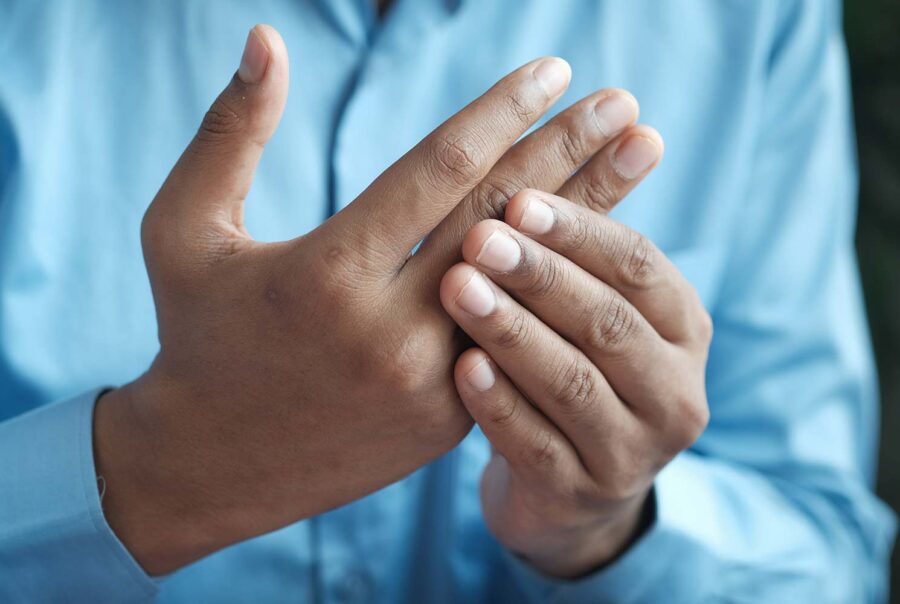About Gout

Do you experience sudden, severe attacks of pain, swelling, tenderness, and redness in your joints, particularly your big toe? If so, you could be suffering from gout, a common form of inflammatory arthritis that affects about four percent of the U.S. population. Triad Clinical Trials developed this resources page to provide information about gout and hopefully answer questions you may have about this painful condition. In it, we’ll be covering everything you need to know about gout, including its symptoms, what causes it, and how it’s treated.
What are the symptoms of gout?
Gout most commonly affects the big toe, although it can occur in any joint. Other commonly affected joints include the ankles, knees, elbows, wrists, and fingers. Gout symptoms almost always occur suddenly and often at night. During a gout attack, you may experience the following symptoms:
- Intense joint pain: The pain tends to be most severe within the first four to 12 hours after it begins.
- Lingering discomfort: After the most intense joint pain diminishes, some joint discomfort may last as long as a few weeks.
- Inflammation: The affected joint may appear visibly swollen.
- Warmth: The affected joint may feel warm, even to the touch. People often say it feels like their joint is “on fire.”
- Tenderness: Even a light touch, such as from a bedsheet, can seem intolerable.
- Stiffness: The joint may feel stiff, making it difficult to move the joint normally.
People who have frequent, severe gout attacks can develop tophi, which are visible bumps made of urate crystals that form in joints, bones, or cartilage. Tophi appear like nodules or lumps that protrude from the skin. While they are usually not painful, tophi can damage joints, destroy cartilage, and lead to bone erosion.
What causes gout?
The human body produces uric acid during the breakdown of chemicals called purines, which are found in your body and in certain foods and drinks. When uric acid levels become too high in the body—a condition called hyperuricemia—uric acid crystals can build up in the joints. These sharp, needle-like crystals cause the symptoms associated with gout.
Who’s at risk for gout?
Gout can affect anyone. However, men are three times more likely than women to experience it because they have higher uric acid levels throughout their lives. Women are more prone to developing gout after menopause, as uric acid levels tend to be higher after menopause.
Men and women are more likely to develop gout if they:
- Are obese or carry a lot of extra weight
- Have certain medical conditions, including congestive heart failure, diabetes, hypertension, insulin resistance, and poor kidney function
- Have a family history of gout
- Eat a diet high in purines, which are found in animal proteins and some types of seafood
- Consume foods and drinks high in fructose (a type of sugar)
- Consume a significant amount of alcohol (especially beer)
- Take diuretics
- Can Lifestyle Changes Help Gout?
In addition to medications, making lifestyle changes is also important in reducing symptoms and preventing future attacks. These include:
- Choosing healthier beverages: Limit or avoid alcoholic drinks, fruit juices, and soda. Instead, drink plenty of water.
- Limiting or avoiding foods high in purines: Certain types of animal proteins and seafood are very high in purines and are best limited or avoided by those with gout. These include red meat, organ meats, bacon, turkey, lamb, venison, anchovies, sardines, mussels, scallops, trout, and tuna.
- Exercising regularly: Because maintaining a healthy weight can reduce your risk of gout, it’s essential to stay active. Choose low-impact exercises, such as walking, biking, and swimming, as they’re easier on your joints.
How is gout treated?
If your doctor diagnoses you with gout, you’ll likely be prescribed medication to reduce your symptoms and prevent future attacks. These include nonsteroidal anti-inflammatory drugs (NSAIDs), an anti-inflammatory drug called colchicine, or corticosteroid medications. If you experience several gout flares a year, experience particularly painful flares, or have tophi, your doctor may prescribe medications to lower your body’s uric acid levels. These medications work by either blocking uric acid production or improving your kidneys’ ability to remove uric acid from your body.
Tophi typically dissolve, albeit slowly, with medication. However, surgery may be required in some rare, extreme instances. There are also several new gout treatments currently available only in clinical trials, like those conducted at Triad Clinical Trials here in Greensboro, North Carolina. Clinical trials may be open to patients interested in new therapies. Clinical trials are free to participants and may include payment for time and travel.
The bottom line.
If you suspect you have gout, it’s important to visit your healthcare practitioner for an evaluation. By recognizing and treating gout early, you can avoid potential complications and improve your overall quality of life.
The content and/or opinions voiced in this Triad Clinical Trials post are for general information only and are not intended to provide specific healthcare advice or recommendations for any individual.

